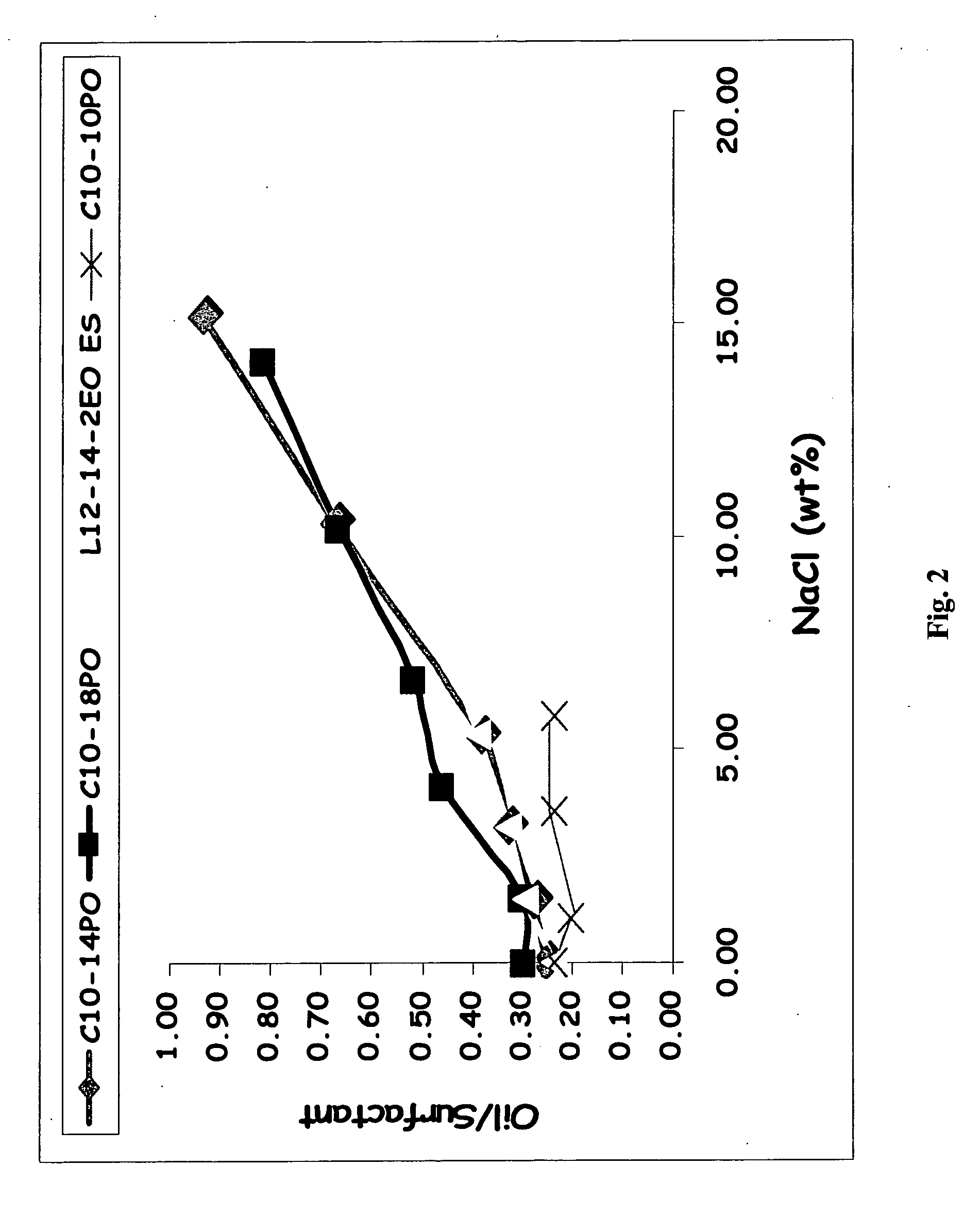Enhanced solubilization using extended chain surfactants
a technology of extended chain and surfactants, applied in the direction of liquid soaps, detergent compounding agents, cleaning using liquids, etc., can solve problems such as flammability
- Summary
- Abstract
- Description
- Claims
- Application Information
AI Technical Summary
Benefits of technology
Problems solved by technology
Method used
Image
Examples
example 1
Preparation of an Extended Chain Surfactant
[0067] Pure-cut C16 alcohol (R16—OH) was reacted first with 10 moles of propylene oxide (PO) at a temperature of 120° C. using a base catalyst and then with 2 moles of ethylene oxide (EO) at a temperature of 160° C. The propylene oxide was allowed to digest completely and vacuum stripped prior to increasing the reaction temperature to minimize formation of allyic species and PPGs. The alkoxylated alcohol was then reacted with chlorosulfonic acid (CSA), vacuum stripped to remove HCl and neutralized with sodium hydroxide in water to give a 25-30% active aqueous solution.
[0068] A second propylene oxide extended ether sulfate was prepared using a linear primary 12-14 carbon number alcohol. The C12-14 alcohol (R12-14—OH) was reacted with 12 moles of propylene oxide and 2 moles of ethylene oxide as above to produce a C12-14 alkoxylated alcohol. The alkoxylated alcohol was then reacted with chlorosulfonic acid and neutralized with sodium hydro...
example 2
Solubilization Test
[0069] Single phase microemulsions of pine oil were prepared using the surfactant blends described below in Tables 1 and 2:
TABLE 1Blend 1CBlend 2CBlend 3CBlend 4CBlend 5CBlend 6CIngredient(wt %)(wt %)(wt %)(wt %)(wt %)(wt %)SXS-40*33.333.333.333.333.333.3SURFONIC ®22.217.813.38.94.40L24-2**SURFONIC ®04.48.913.317.822.2L24-7***NaAES****44.444.444.444.444.444.4(25%)Total100100100100100100HLB88.789.5610.3411.1211.9
**2-mole ethoxylate of linear primary 12-14 carbon number alcohol
***7-mole ethoxylate of linear primary 12-14 carbon number alcohol
****conventional 2-mole EO sulfate based on 12-14 carbon number alcohol
[0070]
TABLE 2Blend 1Blend 2Blend 3Blend 4Blend 5Blend 6Ingredient(wt %)(wt %)(wt %)(wt %)(wt %)(wt %)SXS-40*33.333.333.333.333.333.3SURFONIC ®22.217.813.38.94.40L24-2**SURFONIC ®04.48.913.317.822.2L24-7***NaAES-44.444.444.444.444.444.412PO-2EO****(25%)Total100100100100100100HLB88.789.5610.3411.1211.9
**2...
example 3
Prophetic
[0080] The following cleaning composition may be prepared by mixing the following listed components and then used as a hard surface cleaner:
ComponentWt. %Range Wt. %Surfactant Blend3 1-10C23 branched primary1 1-10alcohol condensed with anave. of 3 moles of EOC24 branched primary2 1-10alcohol condensed with anave. of 21 moles of EOSodium paraffin sulfonate20.5-5Sodium toluene sulfonic20.5-5acidMagnesium sulfate10.5-3Trisodium citrate30.5-6Sodium bicarbonate0.1 0-0.5Sodium phosphate (dibasic)0.1 0-0.5Disodium pyrophosphate0.1 0-0.5Water and minorsq.s. to 100%q.s. to 100%
PUM
| Property | Measurement | Unit |
|---|---|---|
| Fraction | aaaaa | aaaaa |
| Fraction | aaaaa | aaaaa |
| Fraction | aaaaa | aaaaa |
Abstract
Description
Claims
Application Information
 Login to View More
Login to View More - R&D
- Intellectual Property
- Life Sciences
- Materials
- Tech Scout
- Unparalleled Data Quality
- Higher Quality Content
- 60% Fewer Hallucinations
Browse by: Latest US Patents, China's latest patents, Technical Efficacy Thesaurus, Application Domain, Technology Topic, Popular Technical Reports.
© 2025 PatSnap. All rights reserved.Legal|Privacy policy|Modern Slavery Act Transparency Statement|Sitemap|About US| Contact US: help@patsnap.com



